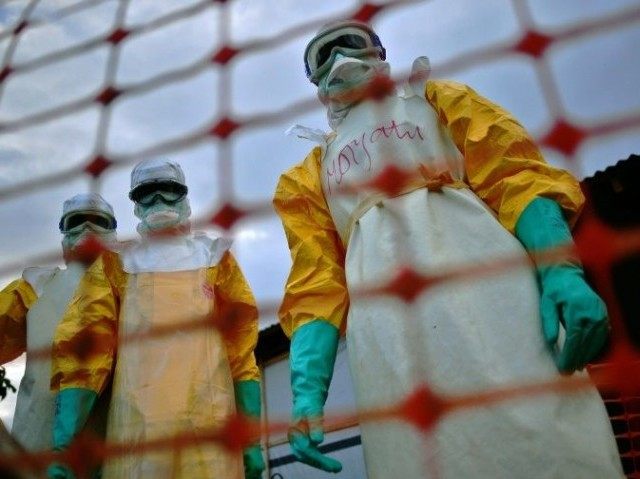Early Mutation Exacerbated Ebola Outbreak

Zika may have elbowed Ebola out of the headlines, but research continues to move forward on the West African epidemic that concluded earlier this year. We’re beginning to learn more about how Ebola works, its capabilities and limitations, how it has evolved over time, and what made the 2014 strain the most ruinous on record.
Ebola has darted in and out of the wild since it first appeared in 1976, periodically testing the integrity of our immune systems in the process. But in none of the previous outbreaks did the virus manage to secure a lasting foothold in human populations. Earlier flare-ups tended to peter out after a few hundred cases at most. There is no question, both in terms of body count and geographic spread, that our latest encounter was different.
After emerging in southern Guinea in late 2013, Ebola raced south to Liberia and Sierra Leone, eventually leaving footprints in a total of ten countries and claiming a total of 11,310 lives. This past January the WHO officially called an end to the Ebola crisis after three years of containment struggles requiring immense doses of cooperation between international and local communities.
Exactly how the West African strain achieved what its predecessors could not has been an ongoing discussion among health authorities and epidemiologists. Many have pointed to regional deficits in public healthcare, which resulted in lower quality care and limited resources available to treat growing populations of infected. At least 20 percent of cases, the WHO estimates, were caused by unsafe burial customs. And as the crisis unfolded, eradication efforts were repeatedly harried by local superstitions that viewed Ebola as a curse rather than a disease and created a growing distrust of foreign medical staff.

These primarily sociological factors threw up challenges in the fight against Ebola, but many wondered whether a change to its genetic profile could also account for its unusual savagery this time around. There was a lot of speculation — and misinformation — at the time that Ebola was now an airborne virus, that like influenza and SARS, it could remain in the air for long durations by hitching a ride on fine aerosols after being ejected from the body with a cough or a sneeze. Those fears were laid to rest, and there is still no evidence that Ebola can be transmitted any way other than through direct physical contact with an infected person’s fluids (e.g., blood, vomit, feces, urine, sperm), which contain high enough concentrations of the virus to transmit to a new host.
But just because Ebola didn’t sprout wings doesn’t discount other genetic changes that might have eased transmission. We now have some pretty major news to share on that front. Research released this month by two independent teams shows that Ebola did in fact change in an important way during the course of the outbreak. Both studies found a mutation that conferred a number of advantages and enabled the virus to outcompete its earlier form.
Researchers believe this mutation, labeled GP-A82V, may largely have fueled the heightened virulence of the West African epidemic. Not only did it allow the contagion to spread at a much faster rate compared with previously circulating strains, it also made it more deadly; patients infected with this new strain were significantly more likely to die compared to spillover events of the past.
The first study analyzed 1,489 Ebola genomes from samples taken from infected patients across West Africa. By plotting the sequences on an evolutionary tree known as a phylogeny, the team observed how the virus developed over time, along with its geographic distribution. In the early months of the epidemic, they discovered, the virus diverged into two distinct strains, one of which quickly predominated and nearly replaced the original strain. Though naturally many mutations arose as the crisis progressed, it picked up one in particular that altered Ebola’s surface proteins, known as glycoproteins (GP).
Before a virus can begin pumping out copies of itself, it first must gain access to the host’s DNA. Think of the proteins comprising the surface of a human cell as differently shaped locks and the proteins studding a virus’ outer shell as sets of keys. If the contact points interlock in just the right way, the virus can maneuver its way inside the host cell. Just one matching combination is enough to jimmy its way in, as typically a virus will target a single host protein.
Could GP-A82V have improved Ebola’s ability to latch onto and enter human cells? To test this hypothesis, Dr Jeremy Luban and his colleagues created a hybrid virus by inserting the Ebola gene responsible for GP production into HIV. (This delicate process is streamlined by the fact that both are single-stranded RNA viruses, with Ebola containing seven genes and HIV consisting of nine.) They ran an experiment with two groups of hybrid viruses. One group contained GP-A82V, and the other group — the control group — contained the original gene. The results were conclusive: GP-A82V improved HIV’s ability to infect human and other primate cells fourfold.
This also appears to explain why Ebola’s already high mortality rate reached 90% in some regions during the West African epidemic. Due to the lower cost of entry, the virus keyed its way through more cells, building up the viral load in the blood and overwhelming the system before immune defenses had time to respond.
Virologist Jonathan K. Ball and his team confirmed these conclusions in a separate study, with some surprising results along the way. Their tree, derived from 1,610 Ebola genomes, returned the same basic patterns: Ebola mutated early and spiraled out of control thanks to a structural change in its surface proteins.
Rather than HIV, Dr. Ball’s group created their hybrids from mouse retroviruses known as murine leukemia virus. Experiments demonstrated that strains with GP-A82V doubled the rate of infection for human cells, consistent with the parallel study. But the most illuminating result of all came when they then ran the same experiment on cells from different species of fruit bats, widely thought to be Ebola’s natural host. Remarkably, GP-A82V had the opposite effect: the same mutation that enhanced uptake in human cells decreased infectivity in bat cells. This finding points to adaptation to a new host — us.
GP-A82V first showed up in the cells of a patient in Guinea back on 31 March 2014, just before the spread intensified. Absent this mutation, it’s likely the number of infected would have dwindled as Ebola followed the example of earlier incarnations and retreated to the wild as it struggled to find suitable hosts.
This latest evidence strongly suggests that Ebola has adapted in unprecedented ways to the human vessel, and may serve as a harbinger of greater unpleasantness to come. Its extended stay during the West African event has cleared the path across the species barrier and helped pave the way for its inevitable reemergence. In the event this latest research leads to new vaccines, we may be better prepared to thwart the next shock to the system, provided we also learn from the mistakes and echo the successes of these past three years.
Further reading:
- Ebola Evolved Into Deadlier Enemy During the African Epidemic
- How Ebola Roared Back
- As Ebola Spreads, So Have Several Fallacies
- Review: The Hot Zone
- Study: Ebola Virus Glycoprotein with Increased Infectivity Dominated the 2013–2016 Epidemic
- Study: Human Adaptation of Ebola Virus during the West African Outbreak


Comments